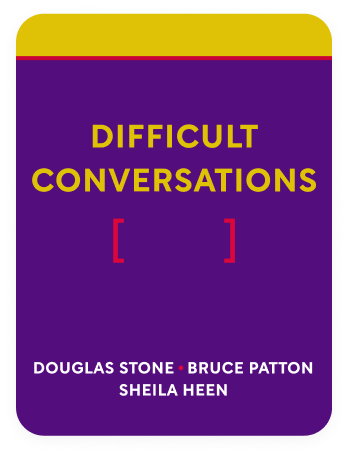

This article is an excerpt from the Shortform book guide to "Difficult Conversations" by Douglas Stone, Bruce Patton, Sheila Heen. Shortform has the world's best summaries and analyses of books you should be reading.
Like this article? Sign up for a free trial here .
What is the best way to resolve a disagreement? What can you do to bridge the gap in understanding and come to a mutually acceptable resolution?
Disagreements happen because of the differences in perception, and in this case, the only truth is that there is no truth. To resolve a disagreement in a constructive way, both parties must be open to considering compromises and accommodating the needs of the other person.
Whatever the cause of the conflict, there is always a way to resolve disagreement constructively. Keep reading to find out how.
How to Resolve Disagreement Effectively
Disagreements are when two people’s respective stories make perfect sense to them, but the stories are in conflict. And when we focus on arguing our own “right” story, we lose the opportunity to explore the other person’s story and understand why they think they’re right.
Arguing any point but failing to understand the other person isn’t persuasive, it’s combative. Telling someone that they are in the wrong (even if they are) won’t help resolve your disagreement. People need to feel understood in their own stories before they can start to change.
To resolve a disagreement constructively, we have to understand each other’s stories enough to see how the opposing conclusion also makes sense. Understanding alone won’t help solve the problem, but it’s the first step toward actually getting to a solution.
Different Stories and How They’re Formed
The stories we tell ourselves are built in systematic, if unconscious ways — they aren’t random or without cause.
How Our Stories Get Built
- First, we all take in information. But there’s so much information to take in that we can only take in a fraction of what’s being offered to us in a given moment — what we take in can be vastly different from what another person takes in, even if they’re sitting right next to us.
- Secondly, after we take in what information we can, then it’s up to our brains to interpret what that information means. This is yet another fork in the road where people can diverge.
- Two factors that influence how we interpret information are 1) our past experiences and 2) the rules we learned about how things should or shouldn’t be done.
- People’s actions and why they make sense only make sense in the context of their past. All our strong views are extremely influenced by our past experiences, and what we learned from our family or other early influences.
- Usually, we’re unaware of just how much our past affects our present interpretation and judgment of information.
- Our past experiences lead us to different conclusions that become “rules” to live by — the shoulds or shouldn’ts that get us into trouble in arguments. Difficult conversations occur when two people’s rules clash.
- However, our conclusions and rules usually reflect self-interest: they support our view and interpret the information favorably based on our conclusions.
- Lastly, we draw conclusions about the information we’ve gathered and how we’ve interpreted it, and we make judgments.
People’s stories can diverge at any of those three steps, or all of them. When there is a disagreement, we usually just assert our conclusions — the last step — without acknowledging the two preceding phases that lead us to those conclusions.
Only we have access to our past experiences and information that form our conclusions. We know ourselves better than anyone else knows us. So we should assume that other people know themselves better than we could ever hope to. We shouldn’t assume that we know what others’ stories are or how others’ stories were built.
Once you’ve unpacked each other’s stories, you still have to work together to resolve the disagreement, but you may still disagree on how best to go about it. This is the resolution stage.
Resolution is essentially collecting the information you just received and coming up with some test options that might help solve both sides’ issues. To resolve the disagreement, both parties must be open to considering compromises and accommodating the needs of the other person.
Test Your (Differing) Hypotheses
Differences in perspective usually stem from assumptions or hypotheses that conflict with each other. We usually keep these assumptions to ourselves, or we might not even know they’re assumptions.
If you can identify what the conflicting assumptions are, then you can come up with a fair test to see whose assumption is more valid, or how much more valid it is.
How to Resolve a Disagreement: Tips and Tricks
1. Communicate what still doesn’t make sense about their perspective. Remember, as you’re participating in a difficult conversation, you’re trying to follow the other person’s reasoning. If you’re having trouble following the reasoning, then there’s information missing that would help their side make sense.
2. Let the other party know what would persuade you, and ask what would persuade them. If you go into a difficult conversation unwilling to be persuaded, you’re not really going into it interested in their side and in solving the problem. Acknowledging that you could be persuaded gives you room to be straightforward about your views and what you need to resolve the issue.
- For example, an employee who’s been asked to work an extra weekend might say, “I understand that you want someone to be able to deal with the supplier issue, but it seems to me that Bill, the assistant manager on the schedule this weekend, can handle it. But maybe you have reservations about Bill that could persuade me he’s not up to the challenge?”
- In the same conversation, that employee might say, “I’ve offered plenty of good reasons why I don’t feel it makes sense for me to work the weekend, yet you don’t seem persuaded. Do you have reasons you haven’t expressed yet? Is there anything I could say to persuade you?”
3. Ask what they would do in your position. This might help you discover other assumptions they have about the situation, or understand their reasoning. “How would you feel if you were in my shoes, and what would you do? Why?”
4. Ask for help coming up with creative solutions. “Can we find a creative way to deal with both our issues? Are you willing to try to find a solution with me?”
5. Look for external standards of fairness. Sometimes, the best place to look for a solution is outside of the difficult conversation you’re having. For example, with the barking dog, maybe there are local ordinances about noise that set a standard that will help solve the dispute, or maybe this issue has come up in the neighborhood before and other people have found alternative solutions.
Agreement Is a Team Sport
Some people feel anxiety over problem-solving, over the task of finding a solution that meets both parties’ needs. They usually feel this anxiety because the goal of a difficult conversation, in their mind, is to make the other person happy — to meet their needs.
But it takes two people to reach an agreement. Unless both people are satisfied, even if it means having to compromise, there is no agreement. You shouldn’t compromise or agree to their terms just for the sake of getting the conversation over — this will breed resentment and ill-will.
“I’m not persuaded that…” is a good phrase for letting the other person know that they’re being demanding without providing good reason. For example, an editor might respond to a pushy writer: “I can see that you’re determined to have this article reviewed, but I’m not persuaded that I should do it now, while I’m on my vacation.” This is clear about the problem, and puts the onus on them to convince you.
Sometimes, reaching an agreement won’t resolve the conflict. No matter how deft the conversation is, there are irreconcilable differences sometimes. You can’t come up with an option that satisfies you both. In these instances, it’s up to you to decide if you can settle for a less than ideal solution for you, or if you can live with the consequences of sticking firm to what you need.
If you decide to stick firm to what you need, explain what needs of yours aren’t being met by the solutions proposed in the conversation and why you’re walking away from solving the issue. Then, know that you’ll have to accept whatever consequences there are.
- For the employee who doesn’t want to work the weekend, he might have to walk away from the conversation with his boss explaining that it’s an important weekend to him and he hasn’t heard any persuasive reasons for why he needs to work — then, he has to be ready to lose his job, if that’s what the consequences are.

———End of Preview———
Like what you just read? Read the rest of the world's best book summary and analysis of Douglas Stone, Bruce Patton, Sheila Heen's "Difficult Conversations" at Shortform .
Here's what you'll find in our full Difficult Conversations summary :
- Why healthy relationships need difficult conversations
- The 3 conversations that happen within each difficult conversation
- How difficult conversations go wrong and what to do about it






